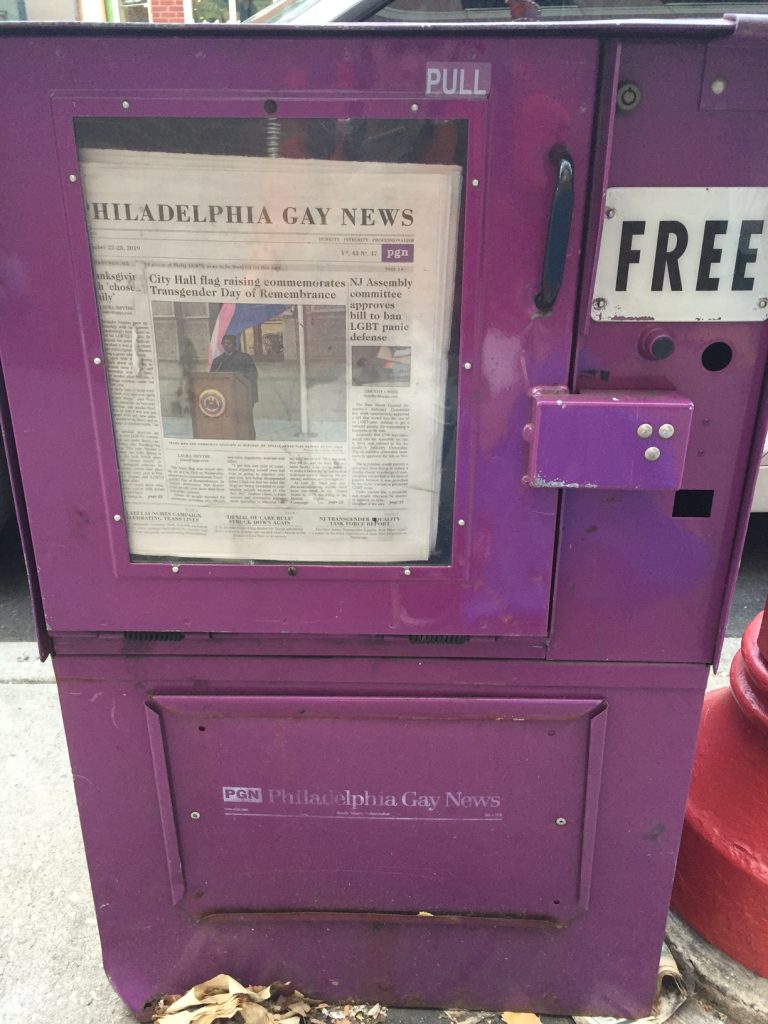Those familiar purple vending boxes dotting the streets of Center City weren’t always there. In the first nine months of its existence, the Philadelphia Gay News was limited to a few local distributors and a subscription service. It was difficult to inadvertently stumble upon the paper as so many people do today. In 1976, like a lot of things in the gay community, one had to know where to find the PGN to get it.
“From the beginning, I wanted everything that any other newspaper had,” Publisher Mark Segal said. “I just didn’t think vending boxes were a reality until the offer from the Bulletin came along. We had no money.
When the Philadelphia Evening Bulletin retired an aging fleet of their vending boxes, Mark Segal and Don Pignolet, PGN’s longtime distribution manager, made a deal to receive them for free. Pignolet fit five boxes at a time into his truck and took them to Earl Shibe Auto for painting. When asked if they would be willing to donate the paint, the workers said sure, but only one color: fresh plumb.

“No one else had that color,” Pignolet said, “and it just seemed so gay.”
The first batch of boxes numbered around 30. When they were ready to be deployed, an announcement was made in the September 1976 issue of the paper: “In order to ensure speedy and convenient local distribution of the Philadelphia Gay News, lavender vending machines for the paper are being purchased and placed in locations throughout Center City. The first area to receive the machines is Spruce St.”
Initially, the paper cost 50 cents per issue. Pignolet and his father attached the coin mechanisms to the boxes, and while they were extremely difficult to set up and more cumbersome to clean and maintain, the funds brought in were used for everything from building supplies to food for the staff.
“The office we had on 13th street was renovated with those quarters,” said Pignolet, who is celebrating 44 years with the paper. “I’d go to a place like 84 Lumber, and I’d pay with not even rolls, but loose quarters. I’d put them in stacks of four and rows of ten.”
Philadelphia’s professional gay newspaper, thanks to the quarters brought in from readers, could finally afford some office repairs (early PGN offices were often in cramped spaces without heat or plumbing). However, beyond serving as a revenue source for the staff, the vending boxes also became a publicity tool for the paper and, more importantly, for the entire community.
“We wanted them to be in high-profile places,” Segal said. “We realized they would be the first gay billboards in the city of Philadelphia. Here they are, purple, with a huge GAY splashed across them. We knew what that was going to mean. We were prepared for any backlash. We expected it.”
As recently as the 2000s, PGN vending boxes had been used as trash cans, vandalized with graffiti, destroyed by fire. The differences between then and 1976 were volume and intensity. Back then, people glued the boxes shut and scrawled homophobic graffiti such as “Gay=Got AIDS Yet?” On several occasions, the boxes were blown up with homemade bombs consisting of M-80 fireworks and a fuse lit by a burning cigarette. Twice the bombs failed to detonate, and Pignolet disposed of them carefully. Repairing the boxes became, for the most part, his full-time job.
“Fire was the hardest to repair. People would open the boxes up and set the paper on fire. Most of them I was able to strip off the burnt paint from the outside, hose it all down and repaint it. Sometimes the insides still have the scars of the fire on the bottom, but as long as I got the smell out, it didn’t much matter.”
The constant destruction forced the staff to get creative and adapt. Pignolet repaired the boxes where he could find space using all manner of tools. (The staff, having heard the continual banging, nicknamed him “Bam-Bam.”) To remove glue from the coin mechanisms, a tungsten carbide rod saw was deployed. And to prevent the clear screens from being destroyed, PGN boxes were some of the first to feature Lexan thermoplastic, a polycarbonate 250 times stronger than glass.
Such herculean efforts are, fortunately, not as necessary today. The PGN now gets vending boxes from a steel manufacturer. The paint, RAL-0007, is found easily enough. The garage at the PGN offices provides ample space for repairs without worry of a leaky roof or frigid cold. The paper is free, eliminating the constant maintenance of the coin mechanisms. It’s a far cry from 1976.
When asked where he found the strength to handle the constant repairs and harassment in the early days, Pignolet said: “Perseverance kept me going. What guided me was a slogan from the early gay rights movement, ‘Never let them have the benefit of our silence again.’ I used that as a motto.”
For the people today who see the purple boxes on the street and feel embraced by the community, for those in the old days who snuck around the corner and snatched a paper while nobody was looking, it’s easy to see: Purple is perseverance. Purple is PGN.
